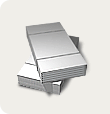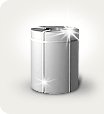Electrical steel is a type of ferrous metal that has improved electromagnetic properties, which in turn is facilitated by silicon. That is, electrical steel is nothing more than iron + silicon. Part two is 1 to 5 percent.
Electrical steel is also called dynamo steel or transformer steel.
Electrical steel is a low-carbon steel with high magnetic permeability. According to the silicon content, it is divided into low-alloyed (0.5-1.8% SI), medium-alloyed (1.8-2.8% SI), doped (2.8-3.8% SI) and high-alloyed (3.8 -4.8% Bi). Silicon increases the electrical resistance of steel, reduces specific energy losses (for hysteresis and eddy currents), and reduces saturation induction and plasticity. Magnetic properties of electrical steel. improved by creating a cubic texture and refining from associated impurities. Low- and medium-alloy steel is conventionally called dynamo steel. Dynamo steel sheets (0.5-1.0 mm thick) are used for the manufacture of rotors and stators of electrical machines. Transformer steel belongs to alloyed and high-alloyed steel. Distinguish between hot-rolled (thin sheets) and cold-rolled (long strips, mostly coiled) steel. Hot and cold rolled transformer steel (sheet thickness 0.35-0.50 mm) is used in the production of cores for power transformers and magnetic circuits, AC hydrogenerators.
Steels and alloys of this type are used as a material with a minimum electrical resistance, or, conversely, to convert electrical energy into thermal energy.
Copper, aluminum, rarely silver are used as conductive materials. Conductor materials should be low in impurities as dopants increase electrical resistance.
A special group of conductive materials is made up of special conductors. With decreasing temperature, a monotonic drop in resistance occurs. However, at temperatures approaching absolute zero (such temperatures are called critical), the resistance of some metals and alloys decreases sharply. For such conductors, alloys Nb - Te, Nb - Zn, Nb - Zn - Cu, Nb - Ge, etc. are used.
The article was written with the support of our partner https://ukrelectrosteel.com.ua/.






